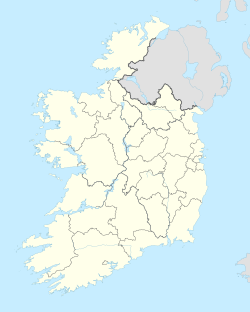History
The abbey was founded in 1190 by Donal Mór O'Brien, King of Thomond and Munster (pre-16th century Clare was called Thomond), who placed there a sisterhood of the order of Saint Augustin. It was a prominent house of Canonesses Regular and was one of a number of female monastic institutions in Gaelic Ireland. [2]
It became associated with the O'Brien dynasty, one of the main Gaelic noble families in medieval Ireland, and several of its abbesses were drawn from their ranks. Among them was Slaney O'Brien (d. 1260), the daughter of Carbreagh, King of Thomond, who renounced her royal status and worldly possessions to take up the role of abbess. [3] [4]
She was described in the Irish annals as "the most pious, most charitable, and most generous woman in all Munster"
The last abbess, Lady Honora O'Brien, daughter of Murrough O'Brien, the 1st Earl of Thomond, played a significant role in the abbey's later history. Following the suppression of monastic houses in 1540, Lady Honora married Sir Roger O'Shaughnessy and became heiress to Newhall and Killone. Their marriage, which required papal dispensation, occurred after the birth of their three eldest children. [2] [5]
By 1617, the abbey was recorded as being in ruins. Today, its remains are located on lands within the grounds of Newhall House and Estate. The ruins include substantial portions of the abbey church and a crypt. A narrow stone stairway, situated between the altar and the east window, leads to a ledge atop the south wall of the church, which overlooks the surrounding grounds.
Saint John's Holy Well
Also located on the grounds of Newhall Estate is the Holy Well of Saint John the Baptist. Known as Tobar Eoin in Irish, the well's origins date to pre-Christian times. According to folklore, the well is believed to have healing properties and has served as a place of pilgrimage for centuries. It features remnants of historical stone structures and a natural spring. Local folklore suggests that the well was visited for blessings and cures, particularly during the feast day of Saint John. It continues to attract visitors. [6] [7] [8]
The well, adorned with inscriptions, some dating to 1600, remains a site of veneration. [9] Lord Walter Fitzgerald (the fourth son of Charles, Duke of Leinster) visited the site in 1899 and documented its history in Inscriptions at St. John's Well, Killone Abbey, County Clare for the Royal Society of Antiquaries of Ireland. [8]
The site is still used for religious services and an annual outdoor Mass is held at the well in June. [10]
This page is based on this
Wikipedia article Text is available under the
CC BY-SA 4.0 license; additional terms may apply.
Images, videos and audio are available under their respective licenses.






